ESP Alfa Romeo 156 2004 Owner handbook (in English)
[x] Cancel search | Manufacturer: ALFA ROMEO, Model Year: 2004, Model line: 156, Model: Alfa Romeo 156 2004Pages: 357, PDF Size: 5.04 MB
Page 115 of 357
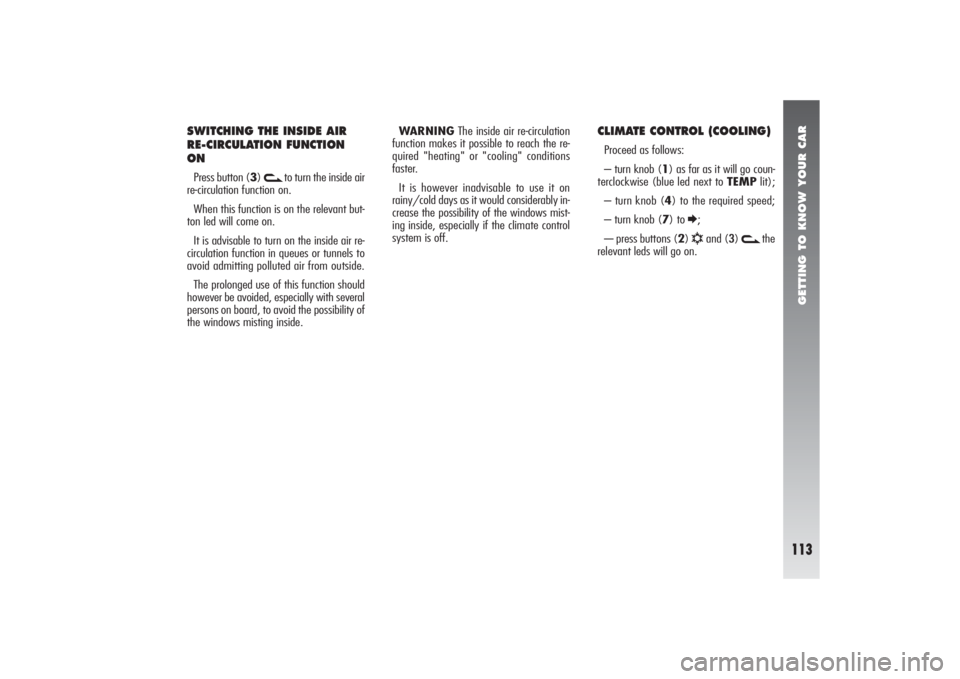
GETTING TO KNOW YOUR CAR
113
SWITCHING THE INSIDE AIR
RE-CIRCULATION FUNCTION
ONPress button (3)
v
to turn the inside air
re-circulation function on.
When this function is on the relevant but-
ton led will come on.
It is advisable to turn on the inside air re-
circulation function in queues or tunnels to
avoid admitting polluted air from outside.
The prolonged use of this function should
however be avoided, especially with several
persons on board, to avoid the possibility of
the windows misting inside.WARNINGThe inside air re-circulation
function makes it possible to reach the re-
quired "heating" or "cooling" conditions
faster.
It is however inadvisable to use it on
rainy/cold days as it would considerably in-
crease the possibility of the windows mist-
ing inside, especially if the climate control
system is off.
CLIMATE CONTROL (COOLING) Proceed as follows:
– turn knob (1) as far as it will go coun-
terclockwise (blue led next to TEMPlit);
– turn knob (4) to the required speed;
– turn knob (7) to
E;
-– press buttons (2) √
and (3)
v
the
relevant leds will go on.
Page 122 of 357

GETTING TO KNOW YOUR CAR
120
AIR TEMPERATURE
ADJUSTMENT KNOBS
(fig. 102)
Turning the rings of knobs (1or 6) clock-
wise or counterclockwise, respectively high-
ers or lowers the temperature of the air re-
quired in the left zone (knob 1) or right
zone (knob 6) of the passenger compart-
ment. The temperatures set are shown on
the displays (2) and (5) placed below the
respective knobs.
Separate operation of the temperatures set
is restored automatically using knob (6) is
actuated.
Turning the knob rings clockwise or coun-
terclockwise, until they reach the extreme
selection positions HIor LO, will cause the
maximum heating or cooling functions, re-
spectively, to be switched on:
fig. 102
A0B0063m
Page 126 of 357

GETTING TO KNOW YOUR CAR
124
FAN SPEED ADJUSTMENT
KNOB
(fig. 106-107)
Turning the ring of knob (3), clockwise
or counterclockwise will cause the fan speed
- and, therefore, the amount of air flowing
into the passenger compartment - to in-
crease or decrease, respectively; the 16
speeds that can be selected are displayed
by a bar (every 3 clicks), up to a maximum
of 6 illuminated bars:
– max. fan speed = all bars lit;
– min. fan speed = one bar lit.
The fan can be cut off (all bars off) only
if the climate control compressor has been
switched off by pressing button (12)
√
.
To resume automatic fan speed control af-
ter a manual setting has been made, press
button (14)
AUTO
. By fully turning the ring
of knob (3) counterclockwise, the system
will be turned off, with the following situa-
tion: display (2) OFF; display (5) OFF; cen-
tral display (4) OFF and left-hand led avail-
able on internal air recirculation button (7)
v
ON and both led on AUTO button
switch OFF.WARNINGBy pressing the internal air
recirculation button (7)
v
, it is possible
to let external fresh air into the passenger
compartment.
fig. 106
A0B0067m
Page 132 of 357

GETTING TO KNOW YOUR CAR
130
With the outside temper-
ature below 2°C the cli-
mate control compressor is unable
to work. It is therefore inadvisable
to use the inside air recirculation
function v
with low outside tem-
perature as windows may mist
over quickly.WARNING
The inside air recirculation
function makes it possible
to reach the required “heating” or
“cooling” conditions faster. It is
however inadvisable to use it on
rainy/cold days as it would con-
siderably increase the possibility of
the windows misting inside, espe-
cially if the climate control system
is off.
WARNING
It is advisable to turn on the
inside air recirculation sys-
tem in queues or tunnels to avoid
admitting polluted air from outside.
The prolonged use of this function
should however be avoided, espe-
cially with several persons on
board, to avoid the possibility of the
windows misting inside.
WARNING
In certain weather condi-
tions (e.g. outside temper-
ature around 0°C) and with auto-
matic air recirculation control on,
mist may form on the windows. In
this case press the inside air re-
circulation button (7)
v
, to
switch off recirculation (leds on
button off) and if necessary in-
crease the flow of air to the wind-
screen.
WARNING
Page 140 of 357

GETTING TO KNOW YOUR CAR
138
HEADLIGHT CORRECTOR (fig. 121)
If the car is fitted with xenon headlights,
beam aiming is electronic and therefore con-
trol (A) on the mask near the steering col-
umn is not present.
The headlights should be aimed correctly
depending on the vehicle load.
The control (A) on the plate at the side of
the steering column can be moved to four
positions corresponding to the vehicle loads
given below:
position 0: 1 or 2 people occupying front
seats, full fuel tank, on-board equipment pre-
sent;
position 1: 5 people on-board;fig. 121
A0B0240m
HAND BRAKE
(fig. 122)
The hand brake lever is located between
the two front seats.
To operate the brake when the vehicle is
“stationary”, pull the lever (A) upwards un-
til the required braking action is obtained.
When the ignition key is in the MARpo-
sition, the
x
warning light will come on on
the instrument panel.
fig. 122
A0B0288m
position 2: 5 people on-board, luggage
compartment full (50 kg approximately);
position 3: Driver and 300 kg in luggage
compartment.
Check the positioning of
the headlight beams every
time you change the load to be car-
ried.
WARNING
Page 143 of 357
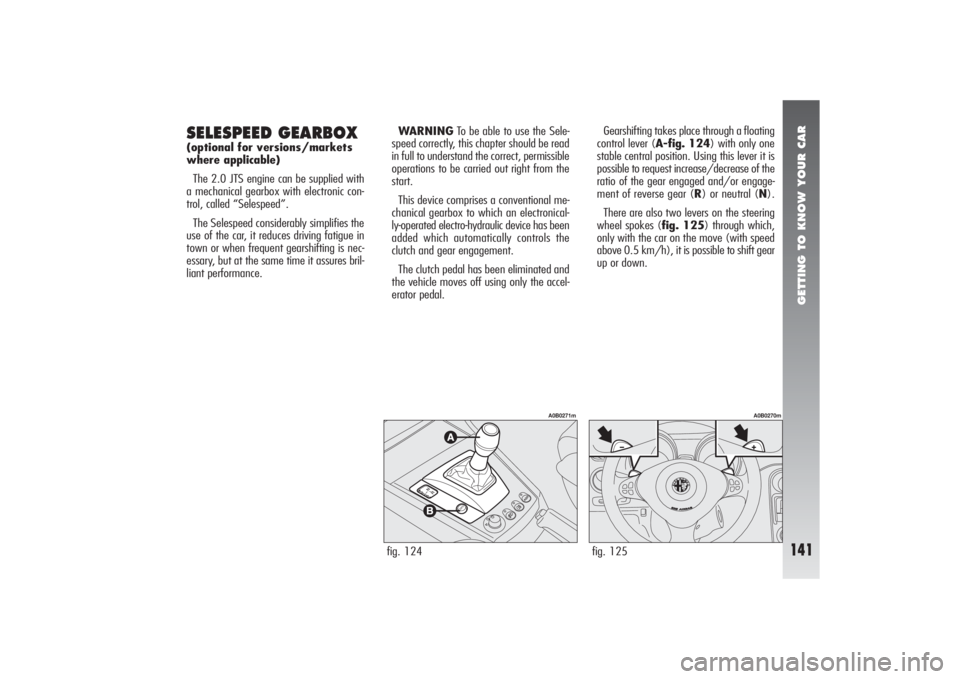
GETTING TO KNOW YOUR CAR
141
Gearshifting takes place through a floating
control lever (A-fig. 124) with only one
stable central position. Using this lever it is
possible to request increase/decrease of the
ratio of the gear engaged and/or engage-
ment of reverse gear (R) or neutral (N).
There are also two levers on the steering
wheel spokes (fig. 125) through which,
only with the car on the move (with speed
above 0.5 km/h), it is possible to shift gear
up or down.
SELESPEED GEARBOX (optional for versions/markets
where applicable)
The 2.0 JTS engine can be supplied with
a mechanical gearbox with electronic con-
trol, called “Selespeed”.
The Selespeed considerably simplifies the
use of the car, it reduces driving fatigue in
town or when frequent gearshifting is nec-
essary, but at the same time it assures bril-
liant performance.WARNINGTo be able to use the Sele-
speed correctly, this chapter should be read
in full to understand the correct, permissible
operations to be carried out right from the
start.
This device comprises a conventional me-
chanical gearbox to which an electronical-
ly-operated electro-hydraulic device has been
added which automatically controls the
clutch and gear engagement.
The clutch pedal has been eliminated and
the vehicle moves off using only the accel-
erator pedal.
fig. 124
A0B0271m
fig. 125
A0B0270m
Page 144 of 357
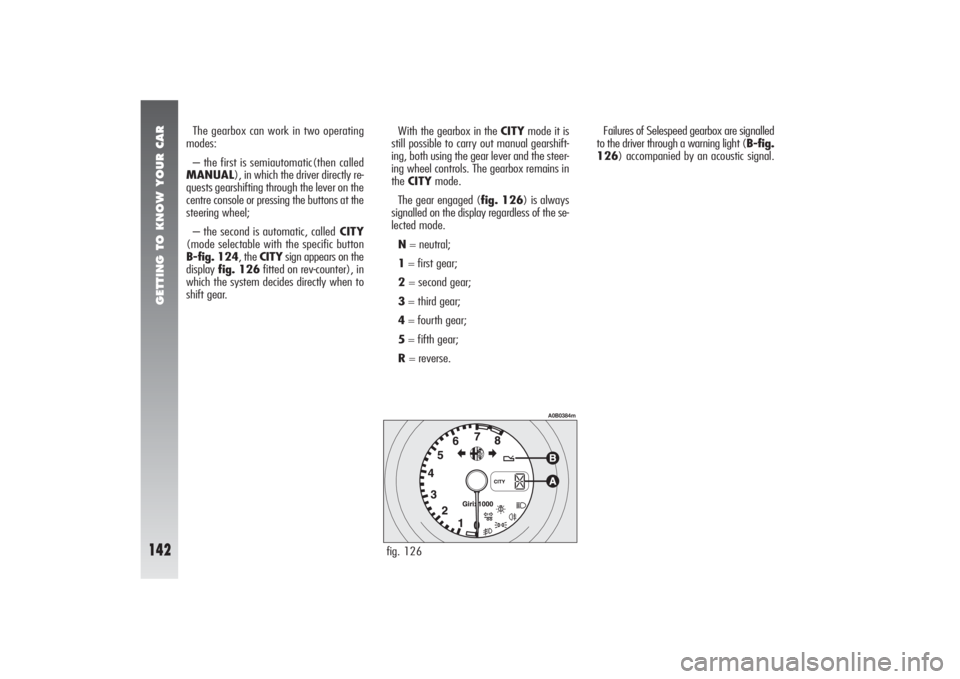
GETTING TO KNOW YOUR CAR
142
Failures of Selespeed gearbox are signalled
to the driver through a warning light (B-fig.
126) accompanied by an acoustic signal. The gearbox can work in two operating
modes:
– the first is semiautomatic(then called
MANUAL), in which the driver directly re-
quests gearshifting through the lever on the
centre console or pressing the buttons at the
steering wheel;
– the second is automatic, calledCITY
(mode selectable with the specific button
B-fig. 124, the CITYsign appears on the
display fig. 126fitted on rev-counter), in
which the system decides directly when to
shift gear.With the gearbox in the CITYmode it is
still possible to carry out manual gearshift-
ing, both using the gear lever and the steer-
ing wheel controls. The gearbox remains in
the CITYmode.
The gear engaged (fig. 126) is always
signalled on the display regardless of the se-
lected mode.
N= neutral;
1= first gear;
2 = second gear;
3= third gear;
4= fourth gear;
5= fifth gear;
R= reverse.
fig. 126
A0B0384m
Page 145 of 357
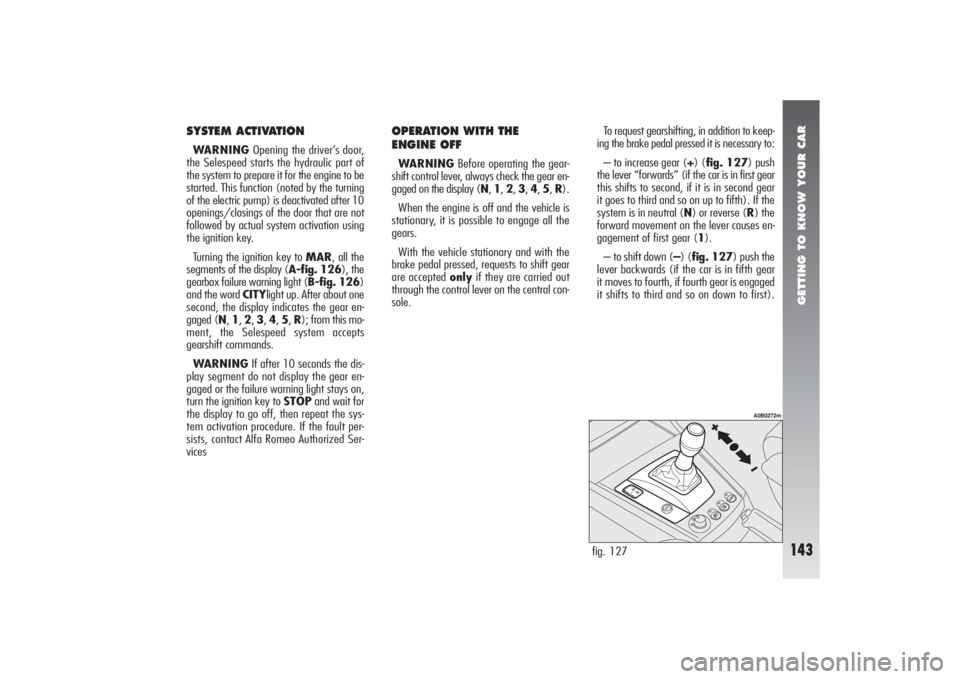
GETTING TO KNOW YOUR CAR
143
SYSTEM ACTIVATIONWARNINGOpening the driver’s door,
the Selespeed starts the hydraulic part of
the system to prepare it for the engine to be
started. This function (noted by the turning
of the electric pump) is deactivated after 10
openings/closings of the door that are not
followed by actual system activation using
the ignition key.
Turning the ignition key to MAR, all the
segments of the display (A-fig. 126), the
gearbox failure warning light (B-fig. 126)
and the word CITYlight up. After about one
second, the display indicates the gear en-
gaged (N, 1, 2, 3, 4, 5, R); from this mo-
ment, the Selespeed system accepts
gearshift commands.
WARNINGIf after 10 seconds the dis-
play segment do not display the gear en-
gaged or the failure warning light stays on,
turn the ignition key to STOPand wait for
the display to go off, then repeat the sys-
tem activation procedure. If the fault per-
sists, contact Alfa Romeo Authorized Ser-
vices
OPERATION WITH THE
ENGINE OFFWARNINGBefore operating the gear-
shift control lever, always check the gear en-
gaged on the display (N, 1, 2, 3, 4, 5, R).
When the engine is off and the vehicle is
stationary, it is possible to engage all the
gears.
With the vehicle stationary and with the
brake pedal pressed, requests to shift gear
are accepted onlyif they are carried out
through the control lever on the central con-
sole.To request gearshifting, in addition to keep-
ing the brake pedal pressed it is necessary to:
– to increase gear (+) (fig. 127) push
the lever “forwards” (if the car is in first gear
this shifts to second, if it is in second gear
it goes to third and so on up to fifth). If the
system is in neutral (N) or reverse (R) the
forward movement on the lever causes en-
gagement of first gear (1).
– to shift down (–) (fig. 127) push the
lever backwards (if the car is in fifth gear
it moves to fourth, if fourth gear is engaged
it shifts to third and so on down to first).
fig. 127
A0B0272m
Page 147 of 357
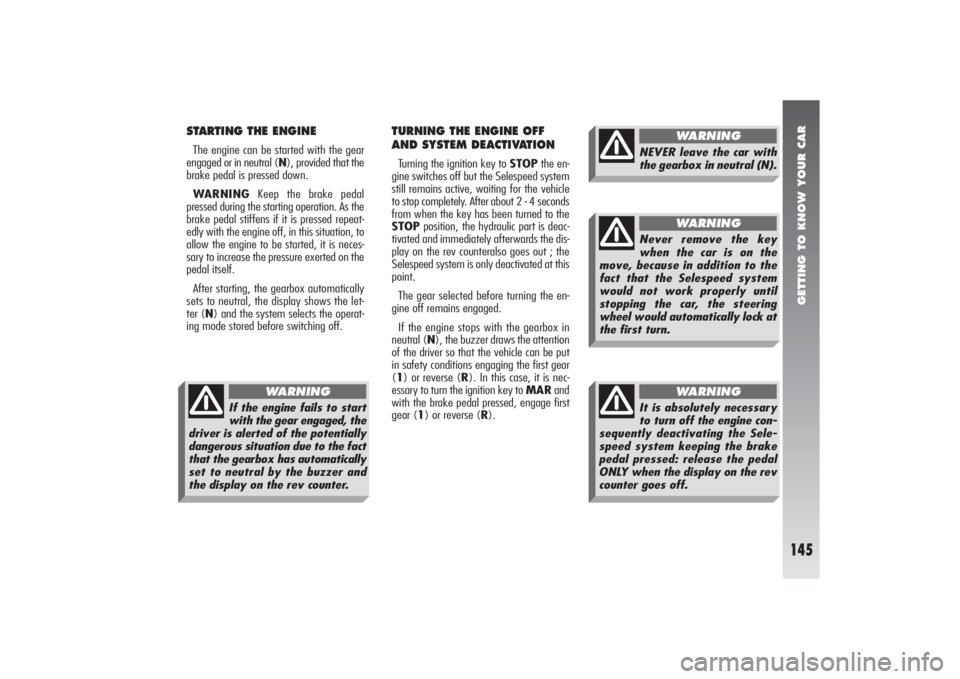
GETTING TO KNOW YOUR CAR
145
STARTING THE ENGINEThe engine can be started with the gear
engaged or in neutral (N), provided that the
brake pedal is pressed down.
WARNINGKeep the brake pedal
pressed during the starting operation. As the
brake pedal stiffens if it is pressed repeat-
edly with the engine off, in this situation, to
allow the engine to be started, it is neces-
sary to increase the pressure exerted on the
pedal itself.
After starting, the gearbox automatically
sets to neutral, the display shows the let-
ter (N) and the system selects the operat-
ing mode stored before switching off.
TURNING THE ENGINE OFF
AND SYSTEM DEACTIVATIONTurning the ignition key to STOPthe en-
gine switches off but the Selespeed system
still remains active, waiting for the vehicle
to stop completely. After about 2 - 4 seconds
from when the key has been turned to the
STOPposition, the hydraulic part is deac-
tivated and immediately afterwards the dis-
play on the rev counteralso goes out ; the
Selespeed system is only deactivated at this
point.
The gear selected before turning the en-
gine off remains engaged.
If the engine stops with the gearbox in
neutral (N), the buzzer draws the attention
of the driver so that the vehicle can be put
in safety conditions engaging the first gear
(1) or reverse (R). In this case, it is nec-
essary to turn the ignition key to MARand
with the brake pedal pressed, engage first
gear (1) or reverse (R).
If the engine fails to start
with the gear engaged, the
driver is alerted of the potentially
dangerous situation due to the fact
that the gearbox has automatically
set to neutral by the buzzer and
the display on the rev counter.
WARNING
NEVER leave the car with
the gearbox in neutral (N).
WARNING
Never remove the key
when the car is on the
move, because in addition to the
fact that the Selespeed system
would not work properly until
stopping the car, the steering
wheel would automatically lock at
the first turn.
WARNING
It is absolutely necessary
to turn off the engine con-
sequently deactivating the Sele-
speed system keeping the brake
pedal pressed: release the pedal
ONLY when the display on the rev
counter goes off.
WARNING
Page 149 of 357

GETTING TO KNOW YOUR CAR
147
STOPPING THE CARTo stop the vehicle, simply release the ac-
celerator pedal and, if necessary, operate
the brake pedal.
Regardless of the gear engaged and of the
operating mode activated (MANUALor
CITY), the system automatically disen-
gages the clutch and downshifts gear.
If you intend to move off again without
having completely stopped the car, this way
the most suitable gear ratio for re-acceler-
ating will be available.
Stopping the vehicle, the system auto-
matically engages first gear (1). Though strongly inadvisable, if due to un-
foreseen circumstances when driving down-
hill the car is allowed to travel with the gear-
box in neutral (N), when the engagement
of a gear is requested, the system auto-
matically engages the best gear to allow
transmission of the torque to the wheels in
relation to the speed of the car.
Downhill with the gear engaged and the
accelerator released (if the vehicle is trav-
elling), if a certain pre-established speed is
exceeded, the system automatically en-
gages the clutch to provide adequate engine
braking.
Due to safety reasons, the Selespeed sys-
tem activates the buzzer when:
– clutch overheating occurs during vehicle
starting; in this case, it is necessary to
“force” moving off avoiding hesitations or
to release the accelerator and use the brake
pedal to park the vehicle if the car is on a
slope;
– the car moves in the opposite direction
to the gear engaged, (e.g.: vehicle moving
forward with reverse engaged); in this sit-
uation it is necessary to stop the vehicle and
keeping the brake pedal pressed, engage
the gear correctly.Still for safety reasons, when the vehicle
is stationary, with the engine started and
gear (1), (2) or (R) engaged, the system
activates the buzzer and shifts to neutral
(N) automatically when:
– there is no action on the accelerator
and/or brake pedal for at least 3 minutes;
– the brake pedal is pressed for over 10
minutes;
– the driver’s door is opened and the ac-
celerator and brake pedal are not pressed
for at least 1 second.